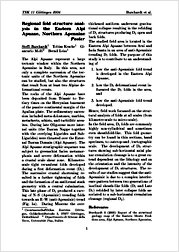Regional fold structure analysis in the Eastern Alpi Apuane, Northern Apennine
2006Universitätsverlag Göttingen
Sammelband- / Konferenzbeitrag
Verlagsversion
Deutsch
Burchardt, Steffi; Kracke, Tobias; Molli, Giancarlo; Leiss, Bernd, 2006: Regional fold structure analysis in the Eastern Alpi Apuane, Northern Apennine. In: Philipp, S.; Leiss, B; Vollbrecht, A.; Tanner, D.; Gudmundsson, A. (eds.): 11. Symposium "Tektonik, Struktur- und Kristallingeologie"; 2006, Univ.-Verl. Göttingen, S. 25 - 26., , DOI: 10.23689/fidgeo-1822.
 |
Dokument öffnen: |
The Alpi Apuane represent a large
tectonic window within the Northern
Apennine in Italy. In this area, not
only a complete succession of the tectonic
units of the Northern Apennine
can be studied, but also the structures
that result from at least two Alpine deformational
events.
The rocks of the Alpi Apuane have
been deposited from Triassic to Tertiary
times on the Hercynian basement
of the passive continental margin of the
Apulian plate. The sedimentary succession
included meta-dolostones, marbles,
metacherts, schists, and turbiditic arenites.
During late Oligocene more internal
units (the Tuscan Nappe together
with the overlying Ligurides and Sub-
Ligurides) were thrusted over the External
Tuscan Domain (Alpi Apuane). The
Alpi Apuane stratigraphic sequence was
subject to greenschist facies metamorphosis
and severe deformation within
a crustal scale shear zone. Kilometrescale
tight recumbent folds developed
during a first deformation event (D1).
The successive crustal shortening resulted
in a further tightening of folds
and the formation of an antiformal stack
geometry with a central culmination.
This late phase of D1 produced a curving
of N–S (Apenninic) trending folds
towards an E–W (anti-Apenninic) trend. During Miocene the overthickened antiform underwent gravitational
collapse resulting in the refolding
of D1 structures producing D2 open and
back folds.
The studied field area is located in the
Eastern Alpi Apuane between Arni and
Isola Santa in an area of anti-Apenninic
trending D1 folds. The purpose of this
study is to contribute to an understanding
of
1. how the anti-Apenninic fold trend
is developed in the Eastern Alpi
Apuane,
2. how the D2 deformational event influenced
the D1 folds in the area,
and
3. how the anti-Apenninic fold trend
developed.

